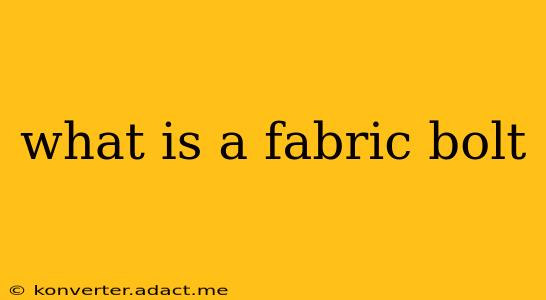A fabric bolt is a large, rolled-up unit of fabric, typically containing many yards of the same material. Think of it as a giant roll of fabric, much like a roll of paper towels but significantly larger and heavier. Understanding what a fabric bolt is crucial for anyone working with textiles, from designers and sewers to wholesalers and retailers. This comprehensive guide will delve into the specifics, answering frequently asked questions and clarifying common misconceptions.
What is a Fabric Bolt's Typical Size?
The size of a fabric bolt varies greatly depending on the type of fabric and its intended use. However, a typical bolt might contain anywhere from 36 to 50 yards of fabric, although some specialized fabrics or remnant bolts might contain fewer yards. The width of the bolt is generally consistent throughout its length and is usually expressed in inches (typically 45" or 60"). This consistency in width makes calculating the amount of fabric needed for a project much simpler.
How is Fabric Sold on a Bolt?
Fabric bolts are the primary way that wholesale fabric is sold. It's a highly efficient method for both manufacturers and retailers, allowing for streamlined storage and distribution. Retailers then cut the fabric from the bolt to meet customer's needs, selling it by the yard or meter.
What are Fabric Bolt Ends?
Fabric bolt ends, or remnants, are the remaining pieces of fabric left on a bolt after a significant portion has been sold. These are often sold at a discounted price, making them a great option for smaller projects or those on a budget. While they might not contain a full 36 or 50 yards, remnants still offer considerable value.
How Much Does a Fabric Bolt Cost?
The price of a fabric bolt can fluctuate wildly based on several factors:
- Type of fabric: Luxury fabrics like silk or cashmere will command much higher prices per yard than cotton or polyester.
- Quality: Higher-quality fabrics, with better dyeing and weaving techniques, generally cost more.
- Quantity: While buying in bulk (a full bolt) often offers discounts, the overall cost still depends on the price per yard.
- Supplier: Different suppliers will have different pricing structures, reflecting their overhead and profit margins.
Consequently, there's no single answer to how much a fabric bolt costs. You need to consider the specific type and quality of the fabric you're purchasing.
What are the Benefits of Buying Fabric in Bolts?
Several key advantages make buying fabric bolts advantageous:
- Cost savings: Purchasing fabric in bulk often leads to lower per-yard prices.
- Consistent quality: A single bolt ensures uniform fabric throughout, ideal for large projects where consistency is paramount.
- Reduced waste: Purchasing a bolt minimizes the need to source multiple smaller pieces of fabric.
- Efficient storage: While requiring more initial storage space, bolts offer better organization compared to numerous smaller pieces of fabric.
What if I Don't Need a Whole Bolt of Fabric?
While many projects require purchasing a full bolt, many retailers sell fabric by the yard or meter directly from bolts. If you need only a small amount of fabric, this is perfectly acceptable and commonly done. Don't let the size of a fabric bolt deter you from purchasing the fabric you need.
This detailed overview should give you a clear understanding of what a fabric bolt is and its importance within the textile industry. Remember to always check with your supplier for details on bolt sizes and pricing for specific fabrics.
